A Postcard from Treblinka
The following is a true account of my personal visit to the camp. Certain names and dates have been changed to protect privacy. All photos are my own.
Mid-summer, Warsaw. Partly sunny, mild—a nice day to visit a death camp. I had just finished with an academic conference in the suburbs of Warsaw, and had one free day (a Tuesday) before moving on to my next European engagement. This was very fortunate, as I knew that the Treblinka concentration camp was only some 100 km away, and I was very much hoping for a chance to see it in person. My local Polish contacts were supportive, if slightly puzzled why an American professor of humanities would bother visiting a place “with nothing there to see.” But I insisted, and so they complied. A Polish colleague, Lech, agreed to travel with me. He had no car, so we booked a taxi—reasonably priced, considering the distance—and by 9:30 am we were on our way to Treblinka.
We would not be arriving as mere tourists. Another colleague previously contacted the camp and spoke with museum director Edward Kopowka. He agreed to meet with us, show us the small museum, and then walk the camp grounds with us for two full hours. Good luck for us, though perhaps not for him.
We made good time, arriving in Malkinia before 10:30 am, and only some 10 km from the camp. But then a problem: the bridge over the Bug River was out of service. We would have to go down to the next crossing at Leg Nurski, about 20 km away, and then work our way back to the camp. This little detour threw our Warsaw-based cabbie for a loop, and with signage virtually nonexistent, I knew we were in a bit of a fix. So we crossed the river, worked our way down to Kosow Lacki, stopped two or three times for directions, drove up past Wolka Okraglik, and on to the entrance of the camp—after 45 extra minutes. But we were there. We drove right in—no gate, no guard, no entrance fee—and parked. Only two other cars in the lot, a relief; no Auschwitz-style Disneyland here.
Lech and I walked over to the small museum (Photo 1). Edward was in his office, ready to see us. He was a clean-cut fellow, probably in his late 40s, and seemed happy to have us. Lech introduced us (in Polish), and I immediately learned that Edward “spoke no English.” Lech would have to translate back and forth—a bit of an inconvenience, I thought, and strange for someone whose job it is to interact with many visitors. But here I was the foreigner, so I couldn’t much complain.
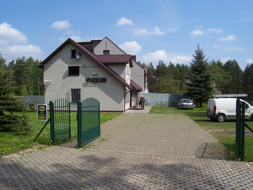
Inside the museum we viewed a large wall map, showing both the labor portion of the camp (Treblinka I), and the “extermination” zone, Treblinka II—see Photo 2. We were presently located at the far right, near the parking “P”, with the museum marked “M”.
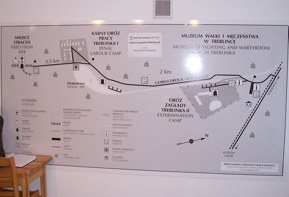
Edward then introduced to us—with Lech patiently translating—a large scale model of the extermination camp (Photo 3). Edward explained the standard extermination process: the arriving train cars, the separation by sexes, the “tube” pathway to the gas chambers, and then the gassing itself—with diesel engine exhaust. Not being your typical ignorant tourist, I asked if diesel exhaust had enough carbon monoxide to efficiently kill masses of people. Edward’s answer: the Germans used “dirty fuel”! This was a new one for me; I am unaware of any witness or perpetrator describing the deliberate use of contaminated diesel fuel in order to increase CO content, nor do I know if it would even work. But it was an interesting response. Evidently, he knew that ordinary diesel exhaust cannot kill masses of people, so the story had to be modified. But who am I to challenge the director of the Treblinka museum himself?
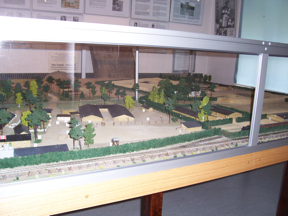
Edward then explained that a total of 912,000 people were killed over the brief, 11-month lifetime of the camp. In fact, this is precisely the figure offered by Manfred Burba in his 1995 German book, Treblinka. Why Edward preferred this number over the other “expert” estimates—including van Pelt’s 750,000, Hilberg’s 800,000, Arad’s 870,000, or Benz’s 974,000—he did not say.
Of the 912,000, the first 700,000 were initially buried in mass graves, he said, and then later exhumed for cremation on open-air pyres—the usual story, but rife with problems. He pointedly did not discuss the timeframe, so I asked (knowing already) if all 700,000 were buried first, prior to exhumation. He hesitated, but finally answered ‘yes.’ So I asked: where exactly were these 700,000 bodies buried? He pointed to a few areas marked “mass grave” on the model. And how much space did they require? A lot, he said. How deep were the graves?, I asked. Eight meters—some 26 feet, a very impressive hole. Isn’t there a ground water problem here, I asked, being a flat landscape so close to the Bug River? Not a concern, Edward replied; the water table is some 10 meters deep. No problems here!
We then proceeded to walk to the extermination camp. One quickly notices that many things about the camp are “symbolic”: symbolic camp entrance (Photo 4), symbolic fence (Photo 5), symbolic railroad tracks (Photo 6). Necessary, Edward says, because the Nazis obliterated every trace of the original camp. How convenient, I thought to myself.
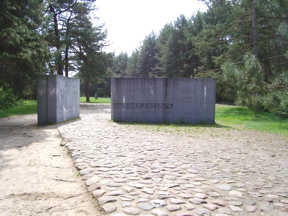
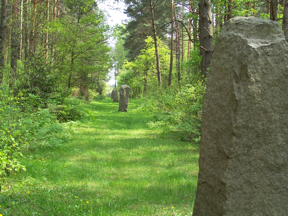
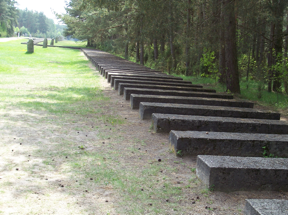
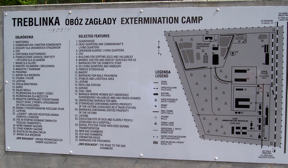
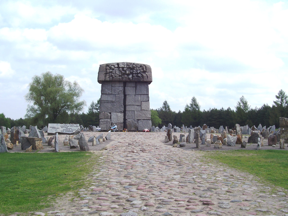
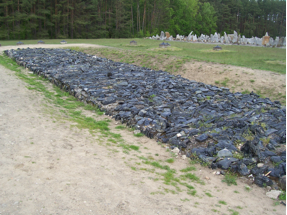
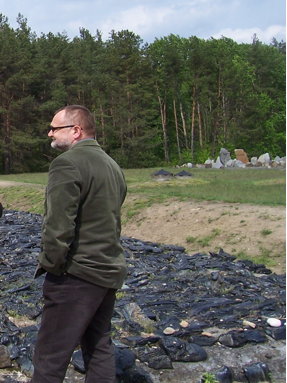
Along the way we passed a large map of the camp area (Photo 7). Unfortunately it bore little resemblance to the present memorial layout, and it was nearly impossible to locate the various “symbolic” markers that we had seen. But perhaps it was just as well—fewer difficult questions to answer this way.
Soon enough we arrived at the pathway (the symbolic “tube”) that led to the famous central monument: a toadstool-like monolith located at the very spot of the alleged gas chambers (Photo 8). Here we were, at the heart of Treblinka, the site of the most horrendous kill rate of the entire Holocaust: of the 912,000 victims, 837,000 were killed in just six months of 1942, according to the camp’s (and Burba’s) “official” tally. (The remaining 75,000 died in 1943.) This works out to nearly 140,000 per month, 35,000 per week, or 5,000 per day, every day, rain or shine, for six months. Not even Auschwitz during the alleged Hungarian massacre could match this rate.
Surprisingly, gassing that many people per day was no problem, on the traditional view. Treblinka had, for most of its existence, 10 chambers with a combined capacity of nearly 40,000 gassings per day; 5,000 would have been a walk in the park. Corpse disposal, on the other hand, would have been a nightmare. Burying the first 700,000 victims would have required astoundingly huge graves. If we accept Arad’s claim of four such graves, each would have had to be something like 15 x 120 meters in area, and 8 meters deep (as Edward claimed), to hold all those bodies. Combined, this is an area equivalent to 1.4 times as large as a professional American football field, and 26 feet deep. (And where did they put all that dirt, by the way?) Upon dumping the bodies for nine months, the Germans then, allegedly, covered the whole mess up—just in time to change their minds and decide to burn them all.
So they uncovered the graves, dredged up 700,000 rotting, decaying corpses, and dragged them over to…a fire pit. To burn them all. Down to pure ash, down to nothing. In the open air. Using wood logs. I asked Edward where this miracle happened. He walked us over to the “symbolic” pit where the Germans had constructed grills of elevated railway rails, on which they could stack the corpses—see Photos 9 and 10. Wood was placed underneath, ignited, and the bodies all but vaporized. And not only did they have the 700,000 exhumed corpses, but they also had to contend with the ongoing supply of 212,000 “fresh” bodies that were still being gassed—at a rate of 5,000 per day. All 912,000 bodies, reduced to ash, in the very spot we were standing. And they did this in just 16 weeks, according to the experts—more than 8,000 per day, every day. Those Germans were brilliant indeed, and efficient.
Where is the ash?, I asked. It’s still in the ground, said Edward. He reached down, scraped around in the dirt with his hand, and said, “Here is some.” He handed me 5 or 6 bits of something that certainly looked like ash: two were black (wood ash?), one was grey, and two white—bone fragments, perhaps? I was quite impressed: here in my hand were the likely remains of actual Treblinka victims. I stuffed the bits of ash in my pocket. I have them still.
During our discussion the question of excavations arose. On the traditional view, the ash was reburied in the graves that held the bodies; even today, there would be literally tons of it remaining. But as we know, there have been no attempts to unearth evidence of mass graves, or to measure or quantify ashes or human remains—not one single attempt, in nearly 70 years. It is almost as if the powers that be did not want to confirm the truth. Perhaps they suspected, in the back of their minds, that the conventional storyline would not hold up. So, I was quite surprised to hear that a team from Birmingham University (UK) was preparing to conduct a non-invasive study of the mass graves, using a ground-penetrating radar. I made a note to myself to follow the progress of this very interesting development.
Our time about up, we walked on back to the museum. Along the way we stopped at a little gift-shop kiosk and purchased two small books: a photo album titled Treblinka: The Stones Are Silent (2007) and a historical overview, Treblinka II – The Death Camp (2007). The latter reiterated that “around 900,000” Jews were killed there, but it included a surprising statistic: “one third of the deportees were dead or on the verge of death when they reached [the camp]” (p. 9). This was a shock: something like 200,000 or 250,000 of the Treblinka victims were dead on arrival? I am unaware of this estimate in any conventional academic work; it would significantly alter the whole story.
The book also mentions the 10 gas chambers, each of 16 square meters in area, which could collectively gas “up to 5000 victims at a time” (p. 13). So: 500 victims per room, which works out to 31 persons per square meter of area. Evidently the authors count on the reader being incapable of basic math—otherwise they wouldn’t put forth this obvious nonsense.
Such was my day in Treblinka. Back in the parking lot, our cabbie was waiting—arising from a little nap. His time might have been better spent. Heading back to Warsaw we took “the direct route,” meaning, we got lost three more times. Finally, two hungry hours later, we arrived back at our hotel. Quite a day. I wouldn’t have missed it for the world.
Postscript
For a long time after my visit, I heard nothing at all about any Birmingham study of the camp using ground-penetrating radar. I was disappointed, but not surprised. Then to my astonishment, just one week ago, came a blazing headline in the British paper The Daily Mail: “British archaeologist destroys Holocaust deniers’ argument with mass grave find at Treblinka” (18 January 2012). The short article reads, in part:
A British forensic archaeologist has unearthed fresh evidence to prove the existence of mass graves at the Nazi death camp Treblinka—scuppering the claims of Holocaust deniers who say it was merely a transit camp. … Forensic archaeologist Caroline Sturdy Colls has now undertaken the first coordinated scientific attempt to locate the graves.
Ms. Colls is quoted as follows:
“I’ve identified a number of buried pits using geophysical techniques. These are considerable in size, and very deep, one in particular is 26 by 17 meters.”
This is the full extent of the details that we are offered—a very strong sign that Ms. Colls did not, in fact, “destroy” the revisionists’ arguments. The presumably largest grave is 26 by 17 meters, or 442 square meters in area. Recall above where I noted that the orthodox story requires a total grave area of roughly 7200 square meters. So Ms. Colls’s one large grave is about 6% of the necessary area. She claims to have found “a number” of graves, but unless this was something like 30 or 40, she is far short of the mark. More likely, of course, the “number” was quite small, or we would surely have been given specifics.
I would further add that, on the revisionist thesis, many thousands of people did indeed die in the camp, of various causes. A high-volume transit camp would have received thousands of incoming dead (recall the “one third” statistic above), and many more would have died of disease and, yes, execution (likely by bullet) at the camp. So it is fully expected that mass graves exist in the camp. But the anticipated number of victims is much smaller—perhaps 10% of those claimed. Thus we might expect to see a total grave volume of around 10,000 to 12,000 cubic meters, rather than the 120,000 required by the conventional account.
So what grave volume did Ms. Colls find? BBC Radio 4 ran a 30-minute exclusive story on this event, on January 23. She spoke several times, but offered very few additional details. She confirmed that a “number” of graves were found, with the largest as mentioned above. But of course, we also need to know how deep they are. The newspaper article quoted her as saying they were “very deep.” But it turns out that her high-tech ground-scanning system cannot record the depth! All she knows is that the graves are “at least 4 meters deep”—evidently the scanning limit of her system. Unbelievable. This is a case of either blinding incompetence, or willful neglect. Any serious attempt to understand the graves would have obviously recorded their depth, at least to the full 8 meters claimed by Edward Kopowka. As it is, and for all she knows, the graves may indeed be no more than 4 meters deep—in which case, her large “26 x 17” grave is a mere 3% of the needed size.
Colls added one further fact on the radio program: the “main area” for graves, right behind the presumed gas chambers, showed evidence of “five graves in a row.” And all five, presumably, are significantly smaller than her largest. This again suggests that she has found only a small fraction of the necessary grave area. The conventional story, and the 700,000 buried corpses, may well have been fatally undermined by this latest discovery. But we won’t know until we see the details of her report—if they ever reach the light of day.
Lacking the details, it’s hard to draw firm conclusions. But all signs point in one direction. They imply that, as at Belzec, ground surveys provide far more support for the revisionist thesis than the traditional one. Things are looking up; the truth is at hand.
Bibliographic information about this document: Inconvenient History, 4(1) (2012)
Other contributors to this document: n/a
Editor’s comments: n/a
